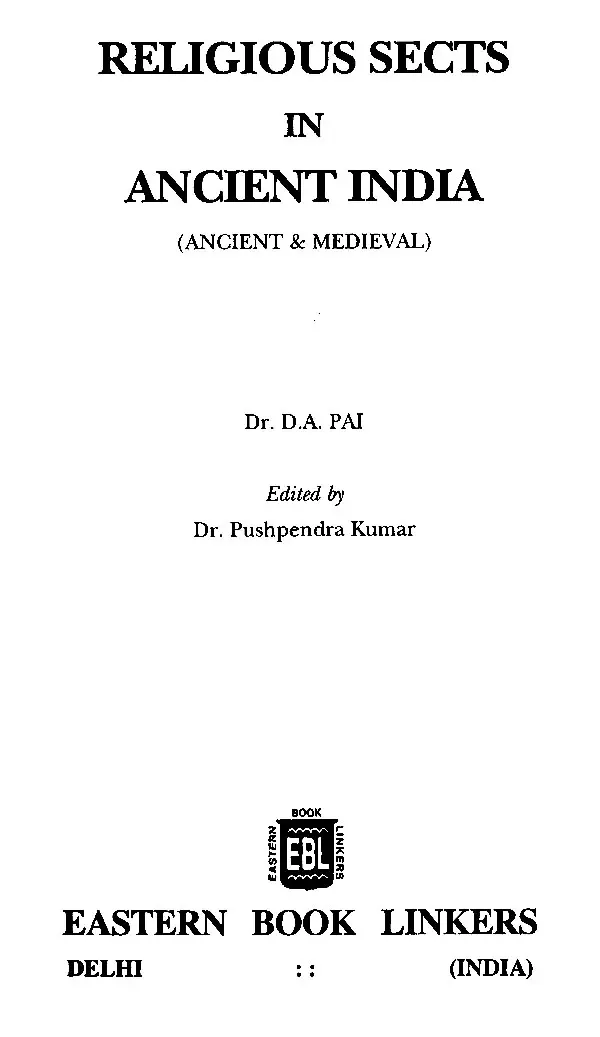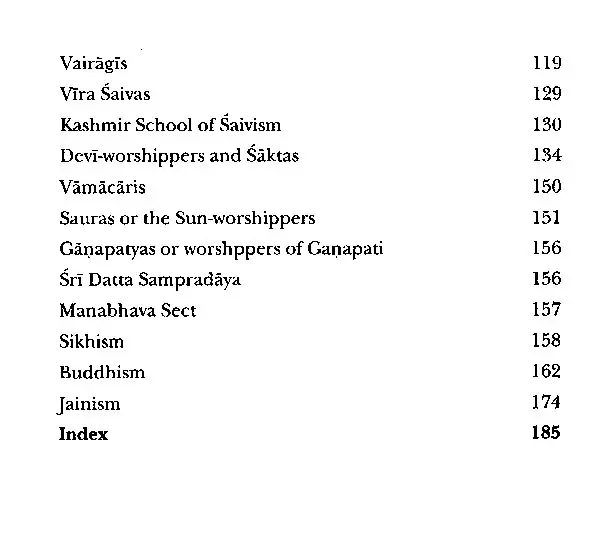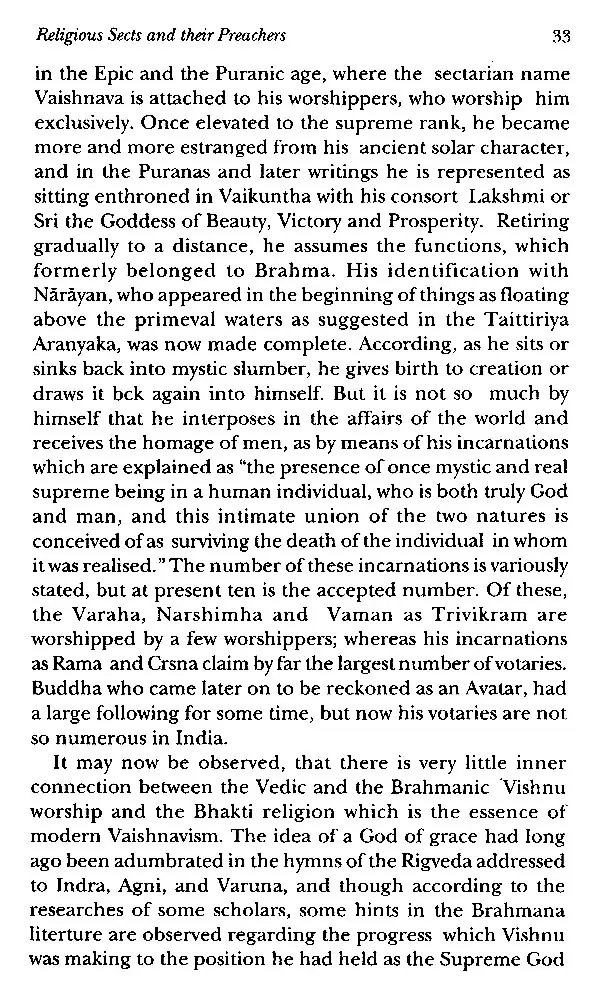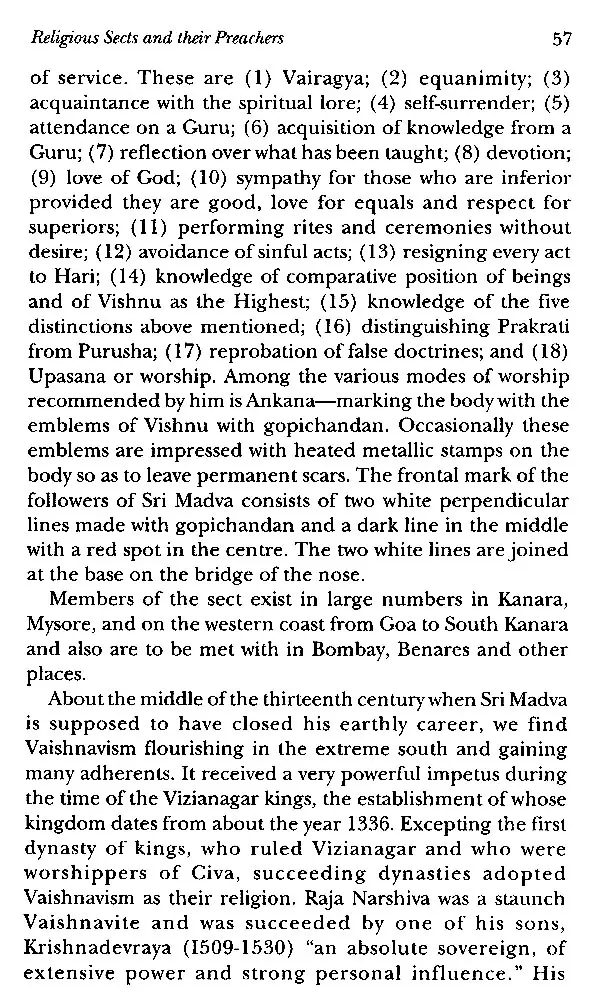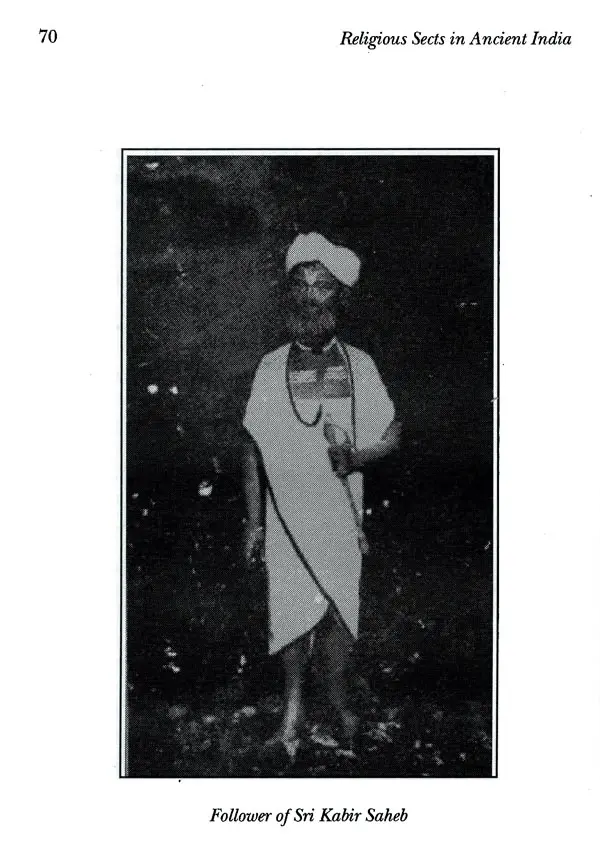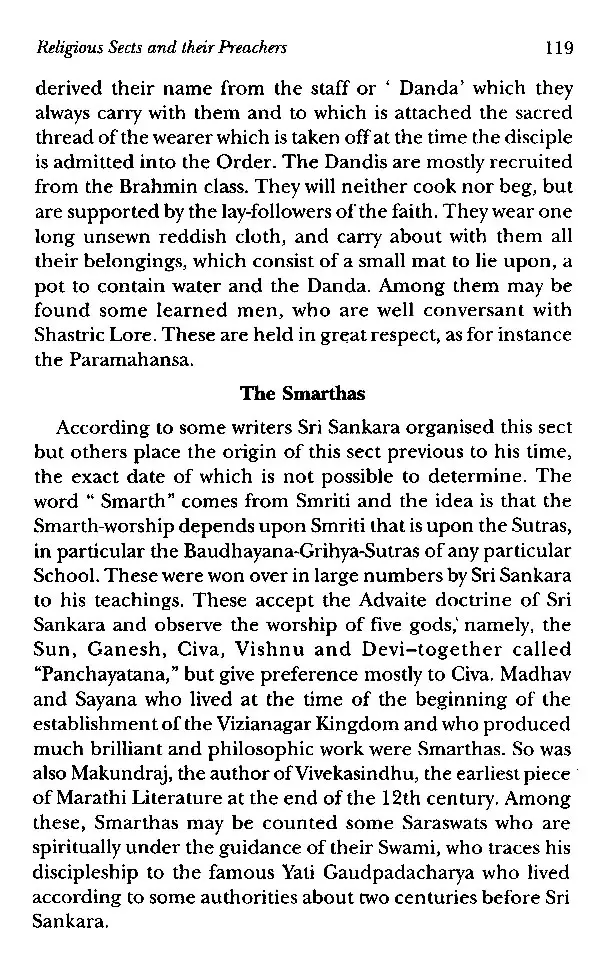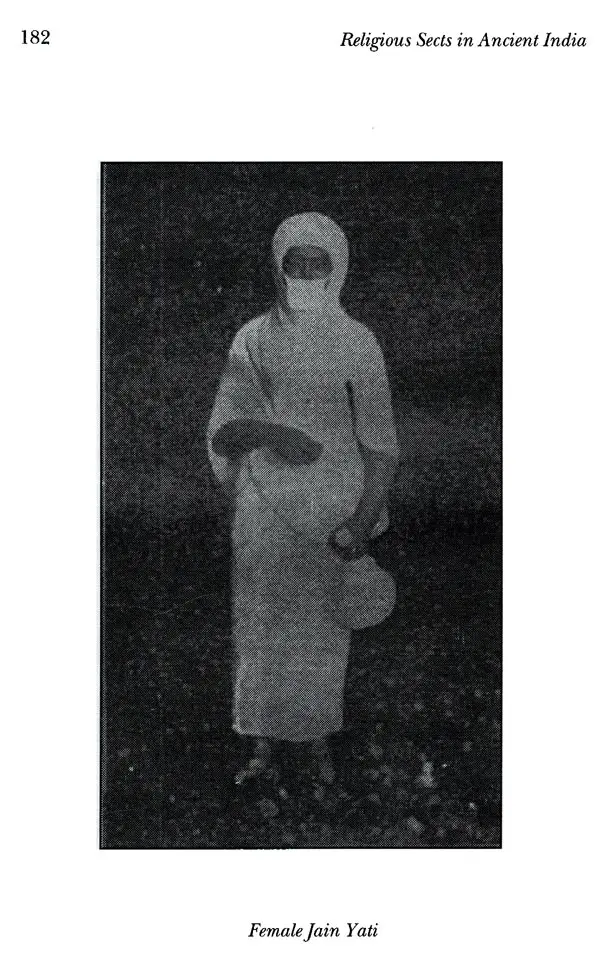
Religious Sects in Ancient India (Ancient & Medieval)
Book Specification
| Item Code: | UAI154 |
| Author: | D.A. PAI & Pushpendra Kumar |
| Publisher: | Eastern Book Linkers |
| Language: | English |
| Edition: | 2017 |
| ISBN: | 9788178543321 |
| Pages: | 201 (Throughout B/w Illustrations) |
| Cover: | HARDCOVER |
| Other Details | 9.00 X 6.00 inch |
| Weight | 350 gm |
Book Description
The book provides a detailed information on the prominent different religious sects that had emerged and developed in the early Vedic period and onwards to the rise and progress of the cult of devotion propagated by the Sikh gurus. It analyses not only the theoretical aspect or supplies the historical background but it also explains the symbology or the creed represented by the paraphernalia in the form of dress, rosaries, sectmarks etc, which are found in the models preserved in the museums all over the country. Among the various religions, that flouurished here, Hinduism, Buddhism, Jainism and Sikhism have received special treatment at the hand of the author.
As to the sources in the preparation of this work the author has utilized the standard literary works, both primary and secondary. Besides the literary and other. sources, Iconography was the most reliable medium of interprethron has been exploited to the utmost.
The author has designed this book to explain the symbology of religious cults as well as to present a vivid historical background of the various religious sects. He has traced the history of the origin, rise and progress of different religious. movements in India, utilizing both the primary and secondary sources. In the latter class he has included the writings which have come to be recognized as standard works of reference on the subject.
The book contains an exhaustive introduction, a general index and sixtynine illustrations including those of the founders of different religious sects and their followers.
India has been a land of various religious creeds since early times. The ealiest literary records of the Hindus-the Samhitas, Brahmanas, Aranyakas and Upanisads reveal that in Vedic India the cult of fire sacrifice went hand in hand with the cult of meditation. The ancient Aryans believed in the efficacy of the Vedic mantras and employed them to fulfil their own material needs. They invoked the deities-Indra, Varuna and others by holding sacrifice, where the priests chanted hymns and made offerings into the sacred fire to propitiate these gods. But there was a revolt among the masses against this priestly order and the people began to question the spiritual supremacy claimed by the Brahmin caste.
As early as the fifth century B.C. Buddhism rose in contrast to Brahmanism and side by side Jainism also flourished. With the advent of Greek rule in ancient India under the rulership of Alexander the Great, Hellenism prevailed on Indian soil. Further, the foreign invaders Kushanas, Sakas and Huns: introduced their own religion. Though they held sway for a short time, over a small part of Indian territory, yet they left traces of their influence over the religious life of India. Vaisnavism, Saivism and Saktism too played their part and played it well. Islam, a foreign entrant on Indian soil was busy also in attracting thousands of Indians to its fold.
Sikhism arose in the Pujnab as a reaction to corruption, as a reformative to and a chastiser of evil which had vitiated the life-current of Indian population. It embibed the vigour of Islam and the devotion of Hinduism. It overtook the masses. in the Punjab and spread with speed getting incentive from the Sikh rulers. The latest arrival was Christianity which. entered and made its impact over all parts of India.
All religions are emanations from saints for the welfare of the people. The founders of creed and their followers live devout lives according to their religious convictions which they express through the variety of forms. Models of the devotees of different sects and their paraphernalia-dress, rosaries, sect marks, etc. are preserved in the various museums all over India.
So far as Indian religions are concerned they possess wonderful mythology and occultism. They are ritualistically symbolical. Those who do not understand the symbology of the ritual cannot appreciate the depth of religious emotion underlying the forms of worship. The ritualistic practices observed with devotional fervour by the devotees are deeply rooted in the convictions which become explicable only when we rightly interpret the symbols, representing ideas and beliefs. preached by the saints or Gurus.
The author has designed this book to explain the symbology of religious cults as well as to present a vivid historical background of the various religious sects. He has traced the history of the origin, rise and progress of different religious movements in India, utilizing both the primary and secondary sources. In the latter class he has included the writings which have come to be recognized as standard works. of reference on the subject.
During my period of office as Deputy Municipal Commissioner (1925-28) I had the privilege of controlling the administration of the Victoria and Ablert Museum, held in trust by the Bombay Corporation in accordance with the arrangement entered into with the, Government of Bombay, and ratified by the Police Charges Act, 1907 (unde section. 89 C of the City of Bombay Municipal Act, 1888). I came in contact with the learned Curator Mr. E.R. Fern, who introduced to me his Assistant, Mr. D.A. Pai, the author of this Monograph on the Religious sects in India among the Hindus. Simultaneously the Commissioner Mr. Clayton. desired that I should go through the Monograph and express my opinion as to whether the Book was worth publishing under the patronage of the Corporation. The examination of the text showed to me that the Bombay Corporation had the good fortune of securing in their service a genuine scholar of Indian antiquities in the person of Mr. Pai. The proposal to publish the monograph initiated by me was supported by successive Municipal Commissioners Messrs. Kirpalani and Clayton and finally accepted by the Corporation under the advice of their Special Committee namely Markets and Gardens Committee.
A museum intended for popular education must be equipped with explanatory monographs relating to the collections exhibited. A specimen of fine art or model must be capble of rousing the "Muses" of the visitor and the enigma of some of the curios must be solved by explanatory notes relating thereto. The learned Curator has provided two catalogues relating to the prints of Old Bombay, and to the Industrial section of the Museum; and his Assistant Mr. Pai has now plced before the public his researches on the Religious sects of India. In this monograph the models of devotees of various religious cults of Hinduism-past and present-together with their paraphernalia in the form of drees, rosaries, sect marks, etc. are explained by means of illustrations. Hinduism with its wonderful mythology and occultism is symbolic in its expression, and those who do not understand the symbology of the various Gods cannot be expected to appreciate the depth of religious emotion underlying the ritualistic froms of worship. The founders willingly done unmindful of the great personal inconvenience caused to him. The suggestion to illustrate the book more profusely than what was thought of before with the object of making it more useful and interesting was made by Mr. H.B. Clayton, C.L.E., I.C.S., the Municipal Commissioner, and it could be carried out, as well as the printing of it under the patronage of the Municipal Corporation chiefly because of the great trouble he took to place the proposal before the members of the Corporation, and induce them to accord their sanction. To all of them I must express my deep obligations, as without their support and sympathy it would have been impossible for me to get the book published.
THE Vedas, which are the source of all the later practices and philosophy of the Indo-Aryans, mainly consist of hymns composed by the earliest bards known as Rsis, who counted amongst them certain pious and learned families. These had obtained preeminence in those times by their knowledge of performing religious sacrifices and the gift of composing hymns. To them, Nature was a living presence with whom they could hold communion. The Sun, the Moon, the Stars, the Sky, the Daw were regarded as divine. The worship of Nature pure and simple, is the earliest form of Vedic religion. Soon reflection set in, and the different phenomena were deified. The feeling, that everything was transitory, that man was weak, and that it was necessary for him to count upon the help of higher spirits in times of danger and difficulty was natural, and nothing could at that early age answer to the feeling so well as the boundless and bright phenomena of the Heavens, which was deified and supposed to be invested with moral attributes. The Earth came in next for her share of adoration, and the union of the two-Heaven and Earth was supposed to produce everything. The Sky was worshipped under the name of Varuna. He was supposed to preside over the regions of the sky and waters, and came to be considered. as the Supreme God upholding heaven and earth and establishing the "Rita"-the Divine Law, which is fixed and immutable. He was supposed to be harsh to the guilty and gracious to the penitent, when he came with prayer and oblations. This marks the beginning of the doctrine of trust in divine forgiveness to the worshipper, which in later ages developed into Bhakti. With the conception of the establishment of Divine Law, the affairs of the world were conceived to be working a ccording to it in a harmonious whole. Then as the Aryans advanced further east and felt that their existence and prosperity depended mostly upon the seasonal and timely falling of the rains, they appealed to the sky, which sent down the fructifying deluge in abundance, and personified it under the name of Indra. He was considered as fighting against the malevolent demons, who kept the rains locked up and assailing their cloud castles till the waters were set free to rush down upon the earth. These fighting qualities attributed to India in the regions above, lifted him in the eyes of the Aryans as a martial God, and he was freely invoked for his blessings and help. It was under his divine patronage that the Aryans were to push their conquests further as they advanced into the regions occupied by the aborigines. He soon became the cherished God of the Aryans, possessing divine authority, ruling over the universe, controller of men's destinies and the friend and helper of those who offered him sacrifices and appealed to him for special favours. In fact, he came to be looked upon as the national God of the Aryans, under whose favour the march of Aryan civilisation was to progress. Turning now to the Atharvan Veda, the composition of which is fairly considered. to run parallel to the Rig, we find it to be a mixture of Aryan and non-Aryan beliefs. "The old hymns inextricably confused, the deities confounded and merged into a new pantheon. strange gods introduced with demons and goblins, incantations for evil purposes and charms to gain wordly ends composed, formulas of maledictions to be directed against enemies and magical verses to obtain children and to prolong life invented; hymns to snakes, to diseases, to pronounce curses, composed-such is in general outline the impression produced by the perusal of the hymns of this Vedic composition. Mention is also found of utterances of spells, charms, incantations, hymns to inanimate things, etc., in the Rig Veda, as mankind has at all times been equally obsessed with fears and superstition; but these were neither encouraged or recognised by the bards of the Rig Vedic period. In their progress onwards, the early Aryans came in contact with wild and barbarous people worshipping snakes, demons, and other mischievous spirits, but because of paucity of their numbers. the only alternative left to them, was to absorb the barbarous hordes and bring them up to a higher level, as the new-comers. could neither swamp the aborigines nor could allow themselves in their turn to be destroyed by them. The result was that along with the people, the rites and superstitions of the older people became absorbed-in fact the religion of the Aryans accommodated itself to its new surroundings. The practice of magic, sorcery and witchcraft, the belief in the efficacy of charms, spells, and incantations, and the belief that men could obtain powers over nature and even over gods, paved the way for asceticism to set in, for we read of great ascetics trying to obtain mastery over Nature by Tapas' or severe penances, such as sitting in the midst of fires, standing on one leg, holding up arms all with the object of subjecting nature and subduing gods to the will of man. But there was also the other side, for we are introduced to the worship to Time (Kal), Kām (Love) and Skambh corresponding to the Rita of the Rig Veda called Prajapati, Purusha, Brahm embracing all space and time, and other moral powers, thus developing further the early traces of theism, which we saw showing themselves in the worship of Varuna and Indra. Rudra in the Rig Veda was a malignant cattle-destroying power, later on associated with Civa-the auspicious, is here the Lord of animals-Pasusupati thus a link between the Vedic worship and Civa worship of later times.
Vedic worship and Civa worship of later times. In the two other Vedas, the Yajus and the Sama the religious spirit is discovered to be more in the background, whilst the ritualistic forms assume importance. The need for prayer books is felt, lithurgy is developed, and the hymns from the Rig are taken and arranged to suit sacrificial necessities. The Yajur Veda contains special hymns to be uttered, when the altar for the sacrifice is to be erected, whilst the Sama contains hymns to be sung at the time when the sacrifice is to be offered.
